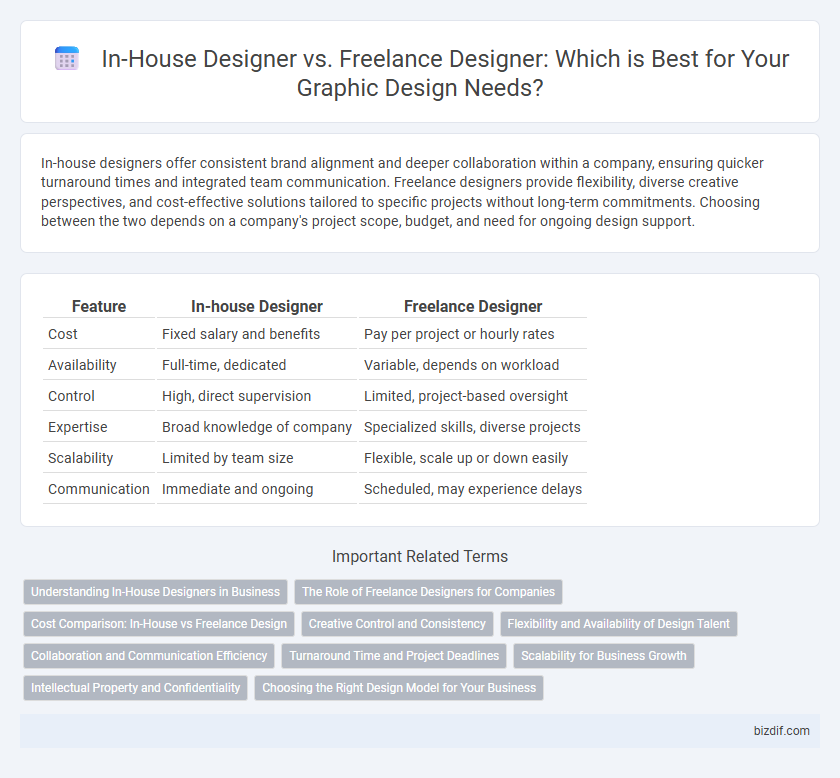In-house designers offer consistent brand alignment and deeper collaboration within a company, ensuring quicker turnaround times and integrated team communication. Freelance designers provide flexibility, diverse creative perspectives, and cost-effective solutions tailored to specific projects without long-term commitments. Choosing between the two depends on a company's project scope, budget, and need for ongoing design support.
Table of Comparison
| Feature | In-house Designer | Freelance Designer |
|---|---|---|
| Cost | Fixed salary and benefits | Pay per project or hourly rates |
| Availability | Full-time, dedicated | Variable, depends on workload |
| Control | High, direct supervision | Limited, project-based oversight |
| Expertise | Broad knowledge of company | Specialized skills, diverse projects |
| Scalability | Limited by team size | Flexible, scale up or down easily |
| Communication | Immediate and ongoing | Scheduled, may experience delays |
Understanding In-House Designers in Business
In-house designers provide businesses with consistent brand alignment and quicker turnaround times by working closely within the company's team and culture. Their deep understanding of the brand's values and ongoing projects enhances collaboration and ensures cohesive visual communication. Employing an in-house designer often leads to more efficient project management and tailored creative solutions that align directly with business goals.
The Role of Freelance Designers for Companies
Freelance designers offer companies flexibility and specialized skills, enabling them to access diverse design expertise for specific projects without long-term commitments. Their ability to adapt quickly to changing brand needs and deliver tailored solutions enhances overall creative output while controlling costs. Companies benefit from the fresh perspectives and innovation that freelance designers bring, often driving more dynamic and effective visual communication strategies.
Cost Comparison: In-House vs Freelance Design
In-house designers typically incur fixed costs such as salaries, benefits, and workspace, which can lead to higher overall expenses for companies. Freelance designers offer flexible pricing models, often charging per project or hour, making them cost-effective for short-term or specialized design needs. Businesses must consider project frequency, budget constraints, and quality requirements when comparing the cost-effectiveness of in-house versus freelance design services.
Creative Control and Consistency
In-house designers provide greater creative control and maintain consistent brand identity due to their deep integration within a company's culture and ongoing projects, ensuring cohesive visual communication. Freelance designers offer flexibility and diverse creative inputs but may struggle with consistent brand alignment without continuous collaboration and clear guidelines. Companies prioritizing consistent branding often benefit from the dedicated focus of in-house teams, while freelancing suits projects needing varied stylistic approaches.
Flexibility and Availability of Design Talent
In-house designers offer consistent availability and immediate access, allowing businesses to maintain tight control over brand consistency and rapidly address design needs. Freelance designers provide greater flexibility by enabling companies to scale talent up or down based on project demands and access specialized skills tailored to specific tasks. Balancing these options depends on a company's workflow, budget constraints, and the need for diverse design expertise.
Collaboration and Communication Efficiency
In-house designers benefit from seamless collaboration and instant communication within the company's team, allowing for quicker feedback loops and cohesive project alignment. Freelance designers often leverage digital tools for communication, which can introduce delays but also offer flexibility in working across different time zones and projects. Efficient collaboration with freelancers depends heavily on clear briefs, structured communication channels, and regular check-ins to bridge the gap of remote work.
Turnaround Time and Project Deadlines
In-house designers typically offer faster turnaround times due to direct access to internal resources and streamlined communication within a company's workflow, which ensures adherence to tight project deadlines. Freelance designers might have variable turnaround times influenced by their workload and availability, potentially causing delays if multiple projects overlap. Prioritizing project deadlines often depends on the freelancer's scheduling flexibility, whereas in-house teams consistently align with organizational timelines.
Scalability for Business Growth
In-house designers provide consistent brand alignment and immediate collaboration, essential for scaling business projects requiring cohesive design strategies. Freelance designers offer flexible scalability, allowing businesses to adjust design resources quickly based on project volume without long-term commitments. Choosing the right model depends on the company's growth pace and need for agile design capacity to support market expansion.
Intellectual Property and Confidentiality
In-house designers typically provide greater protection for intellectual property and confidentiality as they work within the company's secure environment and adhere to internal policies. Freelance designers may pose risks of IP leakage or unauthorized use due to less controlled workspaces and varying contractual agreements. Ensuring robust non-disclosure agreements (NDAs) and clearly defined IP ownership terms is crucial when engaging freelance designers.
Choosing the Right Design Model for Your Business
Selecting the right design model depends on your business's project scope and budget flexibility; in-house designers offer consistent brand alignment and immediate collaboration while freelance designers provide diverse expertise and cost-efficiency for specific tasks. Evaluate your need for long-term creative control against the advantages of scalable, specialized talent on demand. Prioritize factors such as project volume, timeline, and integration with marketing teams to maximize design quality and ROI.
In-house Designer vs Freelance Designer Infographic

 bizdif.com
bizdif.com